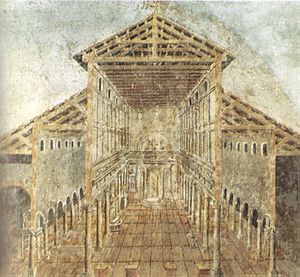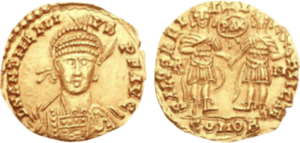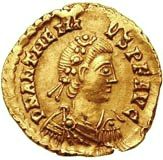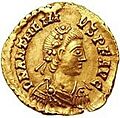Anthemius facts for kids
Quick facts for kids Anthemius |
|||||
|---|---|---|---|---|---|

Solidus of Anthemius marked:
d·n· anthemius perpet· aug· |
|||||
| Roman emperor in the West | |||||
| Reign | 12 April 467 – 11 July 472 | ||||
| Predecessor | Libius Severus | ||||
| Successor | Anicius Olybrius | ||||
| Eastern emperor | Leo I | ||||
| Born | Constantinople | ||||
| Died | 11 July 472 Rome |
||||
| Spouse | Marcia Euphemia | ||||
| Issue | Alypia Anthemiolus Marcian Romulus |
||||
|
|||||
| Dynasty | Theodosian (by marriage) | ||||
| Religion | Chalcedonian Christianity | ||||
Procopius Anthemius (died 11 July 472) was the Western Roman emperor from 467 to 472. He was born in the Eastern Roman Empire. Anthemius quickly rose through the ranks in the Roman army and government.
He married Marcia Euphemia, who was the daughter of the Eastern emperor Marcian. This marriage connected him to the powerful Theodosian dynasty. Anthemius received many important promotions and was even thought to be Marcian's chosen successor.
However, after Marcian's death in 457, another general named Aspar chose Leo to be the Eastern emperor instead. Aspar likely feared that Anthemius would be too independent. Later, in 467, Emperor Leo I chose Anthemius to become the Western Roman emperor. This happened after the Western Empire had been without an emperor for two years.
Anthemius faced two big challenges as emperor. He had to deal with the powerful Visigoths led by Euric and the Vandals led by Geiseric. The Vandals controlled North Africa and often raided Roman lands. Anthemius also had problems with Ricimer, a powerful general of Gothic descent. Ricimer had controlled many previous emperors. Anthemius wanted to rule independently, which led to a conflict with Ricimer. This conflict eventually turned into a war, and Anthemius was killed in 472.
Contents
Early Life and Family
Anthemius came from a noble family called the Procopii. This family had many important leaders in the Eastern Roman Empire. His grandfather, also named Anthemius, was a very important official and a Roman consul. His father, Procopius, was a top military commander.
Anthemius was born in Constantinople, the capital of the Eastern Roman Empire. He studied in Alexandria with a famous philosopher named Proclus. Some of his classmates later became important officials too.
In 453, Anthemius married Marcia Euphemia, the daughter of Emperor Marcian. After his marriage, he was given the title of comes (a high-ranking official). He was sent to the Danube border to help rebuild defenses there.
In 454 or 455, he returned to Constantinople and received the important title of patricius. He also became one of the two top military commanders in the East. In 455, he was honored by becoming a Roman Consul alongside the Western emperor Valentinian III.
These many honors suggested that Emperor Marcian saw Anthemius as a possible future emperor. Some historians even thought Marcian had chosen Anthemius to be the Western emperor.
However, Marcian died suddenly in January 457. At that time, both the Eastern and Western Empires were without an emperor. In the East, the powerful general Aspar chose Leo to be the new emperor. Aspar did not choose Anthemius because he feared Anthemius would be too strong and independent.
Anthemius continued to serve under Emperor Leo. As a military commander, he defended the empire from barbarian groups. Around 460, he defeated the Ostrogoths in Illyricum. In 466/467, he defeated a group of Huns who had crossed the frozen Danube river and attacked Dacia. Anthemius led his soldiers to victory against the Huns.
Becoming Emperor
The Eastern Roman emperor, Leo I, faced a big problem with the Vandals. Their king, Geiseric, often raided the coasts of Italy. After the Western emperor Libius Severus died in 465, the Western Empire had no emperor. Geiseric wanted his own candidate, Olybrius, to become emperor. Olybrius was related to Geiseric through marriage. If Olybrius became emperor, Geiseric would have great power in the Western Empire.
Emperor Leo did not want Geiseric to control the Western court. So, he took his time choosing a new Western emperor. To pressure Leo, Geiseric attacked parts of the Eastern Empire, including Illyricum and Greece. This forced Leo to act.
In 467, Leo I chose Anthemius to be the Western emperor. He sent Anthemius to Italy with an army. On April 12, Anthemius was officially declared Emperor (augustus) near Rome.
By choosing Anthemius, Leo achieved several things. He sent a strong leader away from the Eastern court, preventing him from becoming a rival. He stopped Geiseric from putting his own puppet on the Western throne. And he placed a skilled general with a trained army in Italy to fight the Vandals.
Anthemius' Rule
Working with the Eastern Empire
Anthemius' time as emperor was marked by good relations with the Eastern Empire. They worked together on important decisions, like choosing the yearly consuls. Each emperor would choose one consul, and the other emperor would accept the choice.
In 468, Anthemius had the special honor of being the only consul for that year. The next year, Anthemius' son, Marcian, and Leo's son-in-law, Flavius Zeno, were the consuls. This showed the close ties between the two imperial families.
In 471, the two emperors made their bond even stronger. Anthemius' son, Marcian, married Leo's daughter, Leontia. This marriage further united the two halves of the Roman Empire.
Anthemius also arranged for his only daughter, Alypia, to marry the powerful general Ricimer. This marriage was meant to create a strong alliance.
Fighting the Vandals
The Vandals were the biggest threat to the Western Empire. In late 467, Anthemius launched a military campaign against them. This was a very large operation, with over 100,000 soldiers. However, bad weather forced the Roman fleet to turn back, and the campaign failed.
In 468, Emperor Leo, Anthemius, and general Marcellinus planned an even bigger attack on the Vandal Kingdom in Africa. Leo's brother-in-law, Basiliscus, led this huge operation. A fleet of over a thousand ships carried the combined armies from the East and West. The Eastern Empire paid most of the costs, but Anthemius and the Western Empire also contributed.
However, this massive effort ended in a terrible defeat at the Battle of Cape Bon. Basiliscus gave Geiseric five days to discuss peace, but Geiseric used this time to prepare his ships. He then launched a surprise attack, destroying at least half of the Roman fleet. Basiliscus escaped, and Marcellinus was later killed.
After this disaster, Leo decided to make a separate peace treaty with Geiseric. Anthemius lost his allies and his treasury was almost empty. He had to give up on taking Africa back. Many historians believe this failed expedition was the last real chance to restore the Roman Empire. After this, the Western Empire mostly controlled only Italy and Sicily.
Fighting the Visigoths
After the failure in Africa, Anthemius focused on the Visigoths in Gaul (modern-day France). The Visigothic king, Euric, was expanding his territory and taking over Roman provinces.
In 470, Anthemius recruited Britons to fight Euric. These Britons, led by King Riothamus, initially succeeded and captured the city of Bourges. But when they tried to conquer another area, they were outnumbered and defeated by the Visigoths. Riothamus had to flee.
Anthemius then decided to attack the Visigoths directly. He gathered an army led by his son, Anthemiolus, and other generals. They crossed the Rhone river, but Euric attacked them. The Roman generals were defeated and killed, and the area was plundered.
Governing Italy
Anthemius faced challenges within Italy as well. He was from the East and had been chosen by the Eastern emperor. Some people also suspected he might still follow pagan religions.
To gain support, Anthemius gave the title of patricius to many important senators from Italy and Gaul. He even gave this title to civilians, which was more common in the East. This made the title less exclusive.
One person he honored was the poet Sidonius Apollinaris. Sidonius came to Rome to ask for help for his people. He wrote a special poem for Anthemius, and the emperor rewarded him greatly. Anthemius gave Sidonius the patrician rank and even made him the Praefectus urbi (city prefect) of Rome. Sidonius was so influential that he convinced the emperor to change a death sentence for a Roman official who had sided with the Visigoths.
Coins of Unity
The good relationship between the Eastern and Western Roman Emperors was a positive sign. Anthemius used this in his official coins. His mints in Mediolanum, Ravenna, and Rome produced solidi coins. These coins showed both emperors shaking hands, symbolizing their unity.
Anthemius made Rome his main court, so the mint there became very important. Some coins were also made in the name of his wife, Marcia Euphemia. One coin even showed two empresses on thrones, possibly referring to his daughter Alypia's marriage.
Death of Anthemius

The most powerful person in the Western court was Ricimer, the general who had controlled many emperors before. Even though Ricimer was married to Anthemius' daughter, Alypia, they did not get along. Their relationship worsened when Anthemius accused a senator named Romanus, who was supported by Ricimer, of treason. Anthemius had Romanus executed in 470.
After Romanus' death, Ricimer moved his army north, leaving Anthemius in Rome. Supporters of both sides fought in the city. A bishop helped them agree to a one-year truce.
But in early 472, their conflict started again. Anthemius pretended to be ill and sought safety in St. Peter's Basilica. The Eastern emperor, Leo, sent Olybrius to try and make peace between Anthemius and Ricimer. However, some sources say Leo secretly told Anthemius to kill Olybrius. Ricimer found out about this letter, showed it to Olybrius, and then had Olybrius declared emperor.
The struggle turned into an open war. Anthemius, with the support of the Roman nobles and people, fought against Ricimer and his barbarian soldiers. Ricimer surrounded Anthemius in Rome. There were five months of fighting. Ricimer managed to cut off the city's port, causing Anthemius' supporters to starve.
Both sides asked for help from the army in Gaul. However, the general there, Gundobad, supported his uncle Ricimer. Anthemius tried to get help from another general, but he died trying to stop Ricimer from entering the city.
With no hope of outside help and facing starvation, Anthemius tried to fight one last time. But his men were defeated. The emperor fled again to St. Peter's Basilica (or another church, Santa Maria in Trastevere). There, he was captured and killed by Gundobad or Ricimer on July 11, 472.
See also
 In Spanish: Antemio para niños
In Spanish: Antemio para niños
- Aphrahat (hermit)
Images for kids





